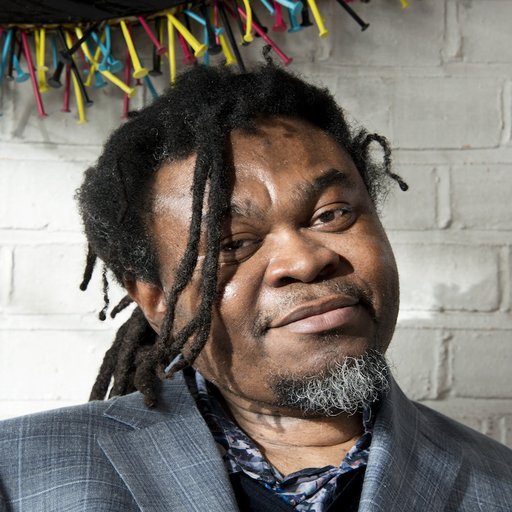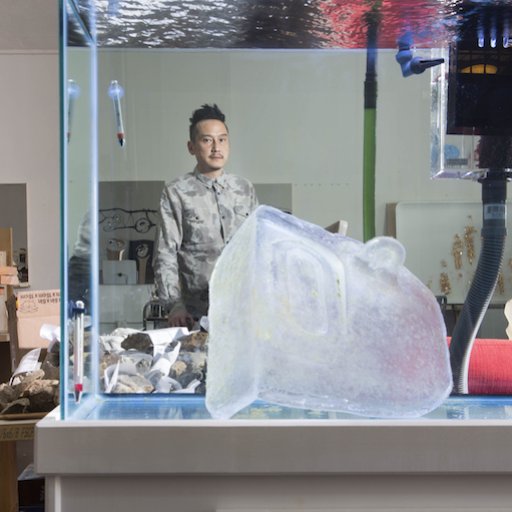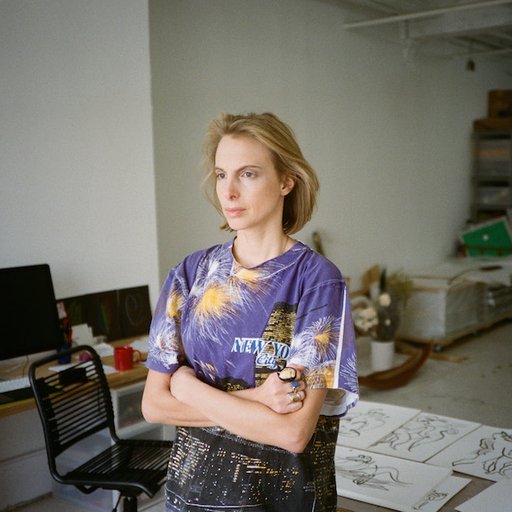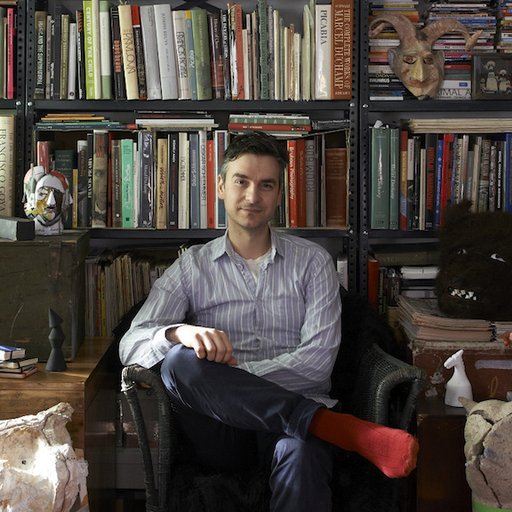A legendary figure in the world of children’s books, the artist Tomi Ungerer is not your typical writer of bedtime stories—in fact, he’s closer to the Sex Pistols. His acclaimed books like The Three Robbers, Moon Man, and Zelda’s Ogre arrived on the American publishing scene in the 1960s as a thrilling rejection of the kind of mushy sentimentality that prevailed in the industry at the time, creating heroes out of such unlikely protagonists as a snake, an alien, and a vulture and imbuing his stories with danger, flashes of violence, kidnappings, and other frightening scenarios.
Championed by the publisher Ursula Nordstrom, Ungerer—whose sensibility can his own menaced upbringing as the child of a widowed mother during the Nazi occupation of France, when his first drawings, as a 12-year-old, were in fact of atrocities committed by the invading Wehrmacht—was the darling of New York’s creative community. Until, that is, he released Fornicon, a collection of imaginatively erotic S&M drawings that effectively led to him being booted out of the country.
The artist is now the subject of “Tomi Ungerer: All in One,” an exhibition at the Drawing Center that surveys the entirety of his career, from his children’s drawings to his voluminous pornographic oeuvre to the fiery political satires that addressed American hypocrisies of the Vietnam War era through cutting absurdist satire. (One of these latter works, a famous poster depicting Uncle Sam’s arm thrusting the Statue of Liberty down the throat of an Asian man, is now being offered on as a new Artspace Edition in conjunction with the museum.) Artspace editor-in-chief Andrew M. Goldstein spoke to Ungerer about the unconventional course of his life’s work.
How would you describe children’s books were being written at the time?
I had been exposed much to American children’s books, and I was shocked when I arrived at the level of them. I thought they were absolutely ghastly in their styles and everything. Ursula Nordstrom was really the only one who was different and had the guts to fight all the mushy sentimentality, all semi-realistic, with smiling children and pink cheeks. Coming from Europe, it was just awful. Still to this day, if you see what’s published in France in children’s books it’s still better than anything that’s published in America. There’s more freedom and more outrageousness and all that.
What was the initial reaction to your work?
Everybody was very nice to me. I came with a whole trunk of drawings and manuscripts, and they were very frank with me. They said, “This is not the way we see things in America—it’s too hard.” And I just listened to the advice I was given, and I went to Golden Books—the biggest publisher was Golden Books—and the guy there as very nice. He said, “This is not at all like our stuff. The only person who would publish anything like this is Ursula Nordstrom.” That’s the way people were very nice to me—if they couldn’t use me for something they would send me to someone who could.
When you first went to meet with Ursula Nordstrom, what did you bring her?
It was an original story that already had the Mellops characters, but it was a horrible adventure where they were kidnapped by a butcher who was going to turn them into sausages. It was too gruesome for the American public, so she said, “I love these piggies, but make me another story.”
Did the Mellops family actually get killed by the butcher in that first book?
Well, I forgot. I never look back at my work, and most of my children’s books I never looked back on again in 50 years. Usually when I’m done with a book I never want to see it again.
That brings us to an interesting quality of your career, which is that every time you create a new book it’s in a different style. Why is that?
It’s like with a challenge—when the challenge is done I go on to other things. That’s the way I am. Right now in fact with all of the satires I’ve done I’ve gone as far as anyone’s ever gone, so I put it all in my writing now, and I write and I write, in three languages of course. I recently had my second volume of aphorisms come out in France and I have another one coming out in German.
What made you so interested in incorporating violence and peril in you children’s books?
It’s really important to expose children to fear, so that they can overcome it. Because that’s what happens in life. Children’s books are there in a way to be immunization—you have to immunize children. But I’ve been very lucky with my books because I’ve had people buying my books and passing them down in their families for four generations now—not in America, of course, because I was banned there.
Political drawings have also been an enormous part of your work, from your illustrations protesting the Vietnam War to your more recent cartoon protesting the massacre of the Charlie Hebdo staffers. Can you talk about these drawings?
Political drawings are something I’ve done all my life, even right now, though now I’m doing more collages. If I didn’t have my work and my creativity I’d be fit for the insane asylum—most artists would. So I’ve been very lucky that everything I feel—especially getting angry and all those things—I can get out of my system by putting it on paper. So this explains my engagement. Even after I left America I’ve been just as active in political drawings, or even more so, when it comes to Franco-German reunification and all those things. And over the past 30 years I’ve also done whole things for AIDS, for cancer, for Médecins Sans Frontières, for Reporters Without Borders—I’ve done posters for them all.
You have been making political drawings over the whole sweep of your career, and in fact the very first drawings you made as a child were violent scenes of the destruction you saw around you during the Nazi invasion of France. The first drawings you made in America that were activated by a political concern were satirical, Goya-esque sketches of segregation in the South.
This was the biggest shock for me when I came to America—the irony that the Americans fought the Nazis to get rid of racism and fascism, which I suffered in my own way through all this fucking brainwashing, and then I come to America and my first father-in-law was the sheriff of Amarillo, Texas, a when I went down there I realized that there was still segregation. My god there, you know, there’s just something that doesn’t click here. It was so shocking that I don’t think I ever got over it. Anything that has to do with injustice puts me into such a state… I just do what I can do. But you can’t change the world with a drawings, so anyway. After I left America I published over 140 books, and many of them are very, very hard satire. One of them is called Babylon, about all of the evils of our modern society. So I’ve kept up, at least. But people don’t buy books of satire anymore.
How did your upbringing in Nazi-occupied France influence your approach to satire?
The Nazis woke up the anger in me, but on the other hand I was exposed to the propaganda of the greatest genius ever, which was Dr. Goebbles. The best way to fight your enemies is to fight them with their own weapons. So, in a way, my Vietnam posters used the same kind of shock effect that I was brought up with. It’s really quite ironical that I should say such a thing, you see.
What kind of reception did your political drawings find?
Those were the days of McCarthyism, and you had the United States of American and then you had New York. And New York has a great tradition, because it’s where all the immigrants arrived and it was a mixing pot, so all the people who were rebelling against other parts of the world came there. In a way, I was very welcome and even fêted in New York for my work. I worked regularly for Ramparts magazine, and I still have all the issues. One day their office was raided by fascists, or rightists, and they tore up all my drawings, so Ramparts gave me my torn-up drawings, which is quite a document.
But I must say that outside of New York I felt very uncomfortable. I had this beard and they would even refuse me drinks and so on—they’d say, “Howdy, stranger, how about you shave your beard off before you ask for a drink.” So I’d pull out a penny with the picture of Lincoln and ask if they’d refuse to serve him too. You had to really watch, though, because you could easily get in trouble in those days. I still have paranoia from those days. Once I was almost kidnapped at an airport, and things got a little more serious after that.
Who tried to kidnap you?
I have no idea. After de Gaulle was the first one to recognize China I could have been one of the first reporters to go to China, so I was in Paris waiting for my visa when I got a Telex saying that if I went I could not expect to be let back into the country. So I flew to Idlewild, now JFK, and after I landed three guys came up, two on my sides and one behind me, and one said, “Tomi, drop you suitcases quietly and follow us.” The guy behind me picked up my suitcases, like in a movie, and the two other guys grabbed me by the arms and dragged me away. They even opened up the soles of my shoes. I never found out who they were! It’s very funny, you never think about looking for identification or anything like this. They were just a bunch of goons. Then after I landed I learned that I had been placed in the black book, and my telephone was tapped. For a while there was a lot of hazing, but that stopped when Kennedy was elected, though I remained in the black book. That’s the reason why every time I come back I’m still nervous.
Where did you display or distribute your political works and posters?
I did my Vietnam War posters originally for the peace movement, and they turned they down—they thought they was too harsh. So I printed they them out of my own pocket and I distributed them on my own through all the poster shops. They went everywhere—you can even see one of them in Stanley Kubrick’s Dr. Strangelove.
It seems at the time that you were much more closely associated with the literary scene than the art world. Why was that?
The problem with America is that you have to follow a movement, and I was always independent. So I went to see Leo Castelli when he was showing Andy Warhol and Pop art, and he explained to me that I had to choose either art or illustration—that you had to do one thing or another, and you couldn’t mix it. I only had one friend who was a critic who wrote about art and he said to me, “Tomi, if I wrote about you, I’d lose my reputation.” Saul Sternberg had it easier because he had a very good friend who was the head of the Museum of Modern Art, so that was different. But even with him that didn’t come until much later, after he retired and started making his paintings. But I was not in the art world at all—it didn’t interest my. All my life I was interested in books. Now, though, I’m doing only fine art, sculptures and all that. I had a huge exhibition in Germany that was 4,000 square meters with my sculptures and collages.
Then in 1969 you came to a turning point in your work, releasing Fornicon, a collection of erotic drawings of women strapped into automated sex machines that marked the beginning of a decades-long dedication to erotica and S&M drawings. How did that come about?
There were wonderful people who helped bring that book out, like Barney Rosset at Grove Press. My god, he had a lot of guts. For every book he brought out he’d have to fight for it in the courts in every state—it cost a fortune. But it was part of the same revolution as the political works. And recently at a signing for my huge book Erotoscope, which is a collection of all of my erotic drawings, there were more women than men. The feminists won! Now women are free and men are free enough to enjoy these kinds of drawings. There’s must greater sexual freedom now. And I have a very highly moral approach, and my principle is that you can do whatever you want as long as you don’t hurt anybody or as long as it’s by mutual consent.
The reaction to the book was swift and severe. Can you talk about what happened?
Well, I was way ahead of my time, and this is what caused me awful trouble in New York. You have no idea! My children’s books were no longer reviewed in the New York Times children’s books section because the editor said that whoever did Fornicon had no right to do children’s books. They put my children’s books in the adult section! And all of my books became banned in all the libraries in America, including the children’s books. When you’re blacklisted no publisher wants you anymore, since you can’t sell to libraries, you know. Even when I went to Canada, the persecution, or whatever you want to call it, kept on going after I left.
Instead of being chastened by this experience and changing your style, you actually doubled down on it, creating ever more explicit erotic drawings.
Because it filled me with even more rage, more anger, and more frustration. All of that was fuel. My insecurity, everything is fuel. I use it.
You moved to Hamburg and lived in a bordello for several years, chronicling its inhabitants in your drawings. Can you talk about that period?
I’m not for prostitution but against pimps, because I think women should be able to decide what they want to do, and I’ve always looked for far-out subjects for my books and reportage. The book I did about the bordello was called Guardian Angels of Hell. But those women are never touched by the clients—they only administrate.I knew a client that would go there once a month and could only have an orgasm if you nailed his tongue to a block of wood. There was another one who could only have four or five orgasms a year, because he could only come if he arrived with a pair of pliers and had a domino pull out one of his fingernails.
And you were a fly on the wall, drawing all of this?
No, no, no, I could never watched, that’s too much. I couldn’t do that. But I was living there and it was like a big family, so they were telling me everything. I’d say, “Tell me about the most outrageous clients you have here.” And I only did one movie about a client who was ready to do whatever, which was shown at 2 a.m. in Germany. It was in a torture chamber. That was the only time I kind of watched it. I’m not a voyeur. But in the bordello, when the girls were busy or in the shop window, sometimes I would welcome the guest and give them a drink.
So you were really part of the family.
I was a good tenant.
How did the reaction to your pursuit of both children’s books and erotic drawings change after you moved to Europe?
Oh, completely. I was made the ambassador to childhood and education at the European Council. For seven years I learned for the Ministry of Education and before that the Ministry of Culture, and in all that time no one had any problem with Fornicon or any of my other books. That’s just an Anglo-Saxon problem, in England and America. I’m still banned in England by law.
In 1998 you won the Hans Christian Andersen Prize, which is like the Nobel for children’s authors, and today there’s a museum dedicated to your work in the city of Strasbourg.
Yes, and up until last year I was the only French artist that the government would give a museum. It’s because I gave Strasbourg something like 15,000 drawings, and every four months they put on a different show. We have guests too—there were wonderful exhibitions of Steinberg and William Steig.
Now your Drawing Center marks a triumphant return to New York. Do you have any hard feelings for the way the city turned on you?
It’s wonderful to be back in New York, just wonderful. There’s no town in the world that I will love as much as New York. Even with the skyscrapers and so on, the spirit just is wonderful.



























